New York Center for Facial Plastic Surgery
Schedule a consultation
Schedule today

Information about rhinoplasty procedures in New York
Rhinoplasty New York – As a world-renowned rhinoplasty specialist, Dr. Jacono has been featured on Good Morning America. Watch to see him discuss nose job surgical trends.
A rhinoplasty is a surgical procedure that surgically improves the shape, width, and length of the nose. Because the nose is the face’s most defining feature, even slight alterations can significantly improve a patient’s appearance.
Dr. Jacono prefers to give his patients natural results that are subtle and aesthetically balanced. Often, his clients request celebrity noses, like Kim Kardashian’s, but he works with each and every patient individually and uses digital morphing technology to deliver their desired outcomes.
“Rhinoplasty” is the technical—or medical—term for what most people refer to as a “nose job.” The goal of this procedure is to refine the nose’s internal structures in hopes of improving its external aesthetics.

Rhinoplasty Before and After Patient 1: – This 25-year-old patient wanted a smaller, more feminine nose. The photo was taken 7 months following her surgery. To accomplish her goals, Dr. Jacono performed a closed procedure, reducing the patient’s nasal hump (dorsal hump), defining her nasal tip, and slightly rotating her tip. Her new nose has brought out her natural beauty; her chin and cheekbones look significantly more balanced.
The open approach is considered to be a more invasive surgery that is better suited to those with larger noses, as well as to those with severely asymmetrical or crooked nasal bridges and nasal tips.
During this procedure, an incision is made across the columella—the thin strip of tissue that connects the nasal tip to the base of the nose—before the nose’s skin is lifted off the underlying bone and cartilage.
The closed approach, on the other hand, is better suited to patients with smaller, more symmetrical noses; typically, “closed” rhinoplasties reshape the tip of the nose, shorten the nose’s length, and shave down the dorsal humps (Hump on the nasal bridge).
Unlike open, the closed technique hides all incisions within the nostrils. Through these internal incisions, the nose can be tactfully reshaped.
Dr. Jacono, an expert in both open and closed surgery, has patented a Quick Recovery Rhinoplasty™ technique that minimizes the visibility of incision lines, does not require the nose to be broken, and reshapes cartilage rather than cuts it away.
Dr. Jacono also notably specializes in revision rhinoplasty, using your body’s own cartilage and bone to reshape the nose.
After surgery, patients’ noses will swell. While the amount of swelling depends on a number of factors—including health, age, and alcohol and tobacco use—patients who have undergone an open rhinoplasty can expect most of their swelling to resolve within 4 weeks.
Patients who have undergone a closed rhinoplasty can expect the majority of their swelling to resolve within 2-3 weeks.

New York Facial Plastic Surgeon Dr. Andrew Jacono is a member of The Rhinoplasty Society and is considered the best rhinoplasty surgeon by his patients and his peers. Dr. Jacono is honored to be one of only 139 members of this elite international society.
During the first week of recovery, patients may feel congested from internal nasal swelling, though Dr. Jacono does not insert packing into the nose. He does, however, cover the nose in a cast that will remain on for the duration of the first-week post-surgery.
Patients should avoid physical activity during this time and should get as much rest as possible.
During the third and fourth weeks of recovery, patients should be able to return to all of their normal activities but should avoid bumping their noses. Patients will notice changes, as most of the nasal swelling will have resolved by now.
Some patients may experience a slight loss of feeling in their nose and should use sunscreen whenever they are out in direct sunlight. Patients may continue to see subtle changes in their nose shape for up to a year.
Anyone of any age who is unhappy with the shape of their nose is a good candidate for rhinoplasty. Those whose noses have significant structural issues that cause breathing problems can also benefit from surgery.
It is important for patients to be in good health (no serious medical conditions or illnesses), and to refrain from smoking or drinking excessive amounts of alcohol before and after surgery.

The best way to choose a rhinoplasty surgeon is to do your research. Peruse as many physicians’ websites as you can, evaluate their results, and schedule a consultation to see if the surgeon in question is a fit.
Dr. Jacono is a dual-board-certified facial plastic surgery expert and pioneer with over twenty years of experience in the field. He has extensive training in both a rhinoplasty and revision rhinoplasty surgery and prides himself on delivering the most natural, comprehensive results possible.
To see if you are a candidate for rhinoplasty surgery with Dr. Jacono, please contact our offices in New York City or on Long Island.

The following photographs show some of Dr. Jacono’s before-and-after rhinoplasty results. These images have not been altered for presentation.
Dr. Jacono performed a closed procedure on this 20-year-old patient, who wanted a smaller, more feminine nose. He reduced her nasal hump and created a more refined nasal tip.


Unhappy with her bulbous tip and large dorsal hump, Dr. Jacono smoothed her nasal hump and reduced her nasal tip. Her nose now completely complements her other facial features.


This young lady wanted to reduce her dorsal hump and nasal tip. Dr. Jacono performed a closed rhinoplasty procedure to correct both issues. Her after photographs were taken just three weeks after surgery. She loves her new look, and is already posting pictures all over Instagram.


An unhappy patient with her bumpy nasal bridge and downward-sloping tip. Dr. Jacono performed an open rhinoplasty to reduce her dorsal hump and refine her nasal tip.
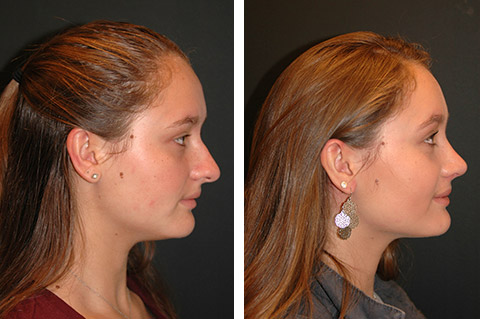
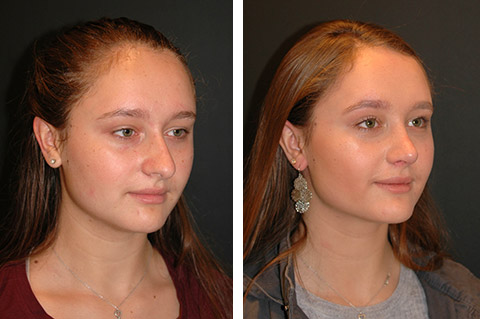
This 18-year-old patient underwent an open rhinoplasty with Dr. Andrew Jacono and is pictured here 4 weeks post-surgery. Her goal was to have a smaller, more feminine nose by reducing her nasal hump (dorsal hump), defining and rotating her nasal tip, and reducing her nostrils. Dr. Jacono performed an alar base reduction to address the nostrils. The balancing of her nose has enhanced her beauty, with her cheekbones and chin appearing more symmetrical. The result is stunning, and she exudes a newfound confidence!


20-year-old patient wanted a smaller, more feminine nose. Dr. Jacono reduced her dorsal hump and slightly lifted her nasal tip. He also performed an alar base reduction to make her nostrils smaller.


This patient underwent an open nose job with an alar base (nostril) reduction, which correct her over-projected nose, and droopy tip, and dorsal hump. After surgery, her face appears more feminine and aesthetically balanced.
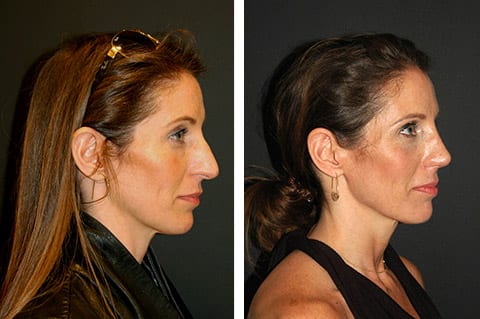
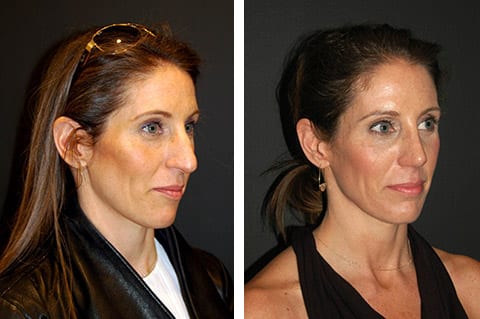
Dr. Jacono performed a closed technique on this young lady. He also performed a nasal tip plasty to reduce her long, bulbous nasal tip.


Young woman who wanted to refine her nasal bridge and lift her tip. Dr. Jacono performed a closed rhinoplasty, reducing her nasal bridge and building up her radix with a cartilage graft (the radix is the “root”, or uppermost part, of the nose).


Female nose job patient was unhappy with her wide nostrils and nasal hump, so to address her concerns, Dr. Jacono used a closed approach and she is extremely happy with her results.


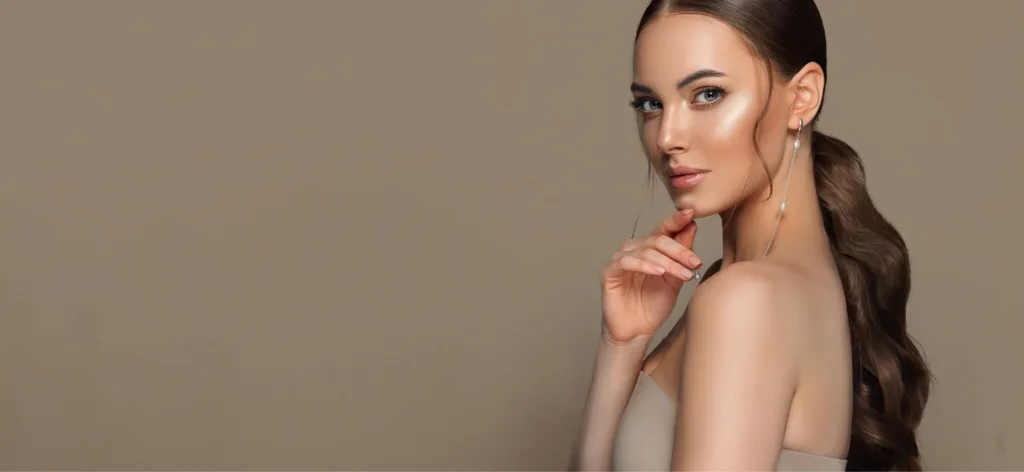
Accessibility: If you are vision-impaired or have some other impairment covered by the Americans with Disabilities Act or a similar law, and you wish to discuss potential accommodations related to using this website, please contact our Accessibility Manager at (212) 570-2500 .